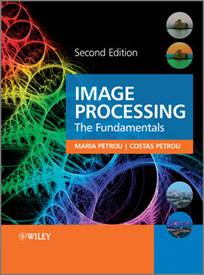|
Although many books are available in the area of image processing, this book “Image Processing, the Fundamentals” by Maria Petrou and Costas Petrou explains this subject in a distinctive way. In this book, the authors have attempted to capture new insights with a lot of examples in all the fundamental topics of image processing. The book introduces the mathematical foundations of image processing in a state of the art way. Basic topics like image enhancement, image restoration, and feature extraction are discussed in detail with various examples supporting the theory. The chapters of the book are written in an interactive format where many questions and answers describe the theoretical concepts of each topic discussed. The examples are supported by simulated image results which offer more clarity of results in the reader’s mind. The book is accompanied by a CD with all of the MatLab programs for each chapter. The MatLab programs are intended to support the examples explained in the book. The CD also contains a collection of slide presentations in pdf format which to go along with the book’s web page. This material may help the lecturer to teach this subject. In this book, the authors have made a great effort to explain all the nuts and bolts behind the image processing concepts which increases the reader’s interest while reading this book. This book would definitely help students to improve their example-solving skills. The book contains seven chapters. The first chapter provides an introduction to image processing where all the basic terms like resolution, restoration, and point spread function properties of a system are explained with examples. In the second chapter, image transforms, such as SVD, Haar, Walsh, and Hadamard transforms, are explained. DFT is also explained, with concepts of odd end even symmetry, in much detail with many examples. The third chapter mainly focuses on the statistical description of images, which is the background required to understand many image processing algorithms. In the previous chapter, the formation of the bases of an elementary image were discussed. In this chapter, the basic concepts of probability and random variables are described in the spatial domain. The transformations of an image into a basis of elementary images for optimal expression are explained with different transforms, like the KL transform and independent component analysis (ICA). The forth chapter addresses details of the image enhancement process. It is a very basic and important pre-processing step. The elements of linear filter theory are explained in the frequency domain with various examples. It also describes types of noise and spatial and frequency domain filtering methods. Contrast enhancement can be better achieved by histogram manipulation techniques which are also illustrated in detail. The fifth chapter focuses on image restoration and the basic methods, like inverse filtering, Wiener filtering, and homogenous and inhomogeneous linear image restoration techniques, are described with the required basic mathematical derivations. Nonlinear image restoration MAP estimation and geometric image restoration techniques are also explained. The sixth chapter is about image segmentation and edge detection methods. In this chapter all the basic segmentation methods, like histogram based, split and merge, and morphological watershed method, with their limitations and advantages are presented. Edge detectors play an important role in object recognition, so the most widely used ones—Sobel, Canny, Laplacian, and the Gaussian edge detector—are explained with lots of details and the derivations of each one. I must say that authors have taken lot of effort to clarify all these concepts with examples. For instance, phase congruency, monogenic signal, and non-maxima suppression are some of the difficult topics that are clarified with derivations and examples. In the last chapter, multispectral image processing methods and basic concepts of color image processing are addressed. The physics and psychophysics of color vision are described with more detail than I have found elsewhere in the literature. The color image system spaces and different color image processing methods used in practice to enhance color image are illustrated with a number of simulated results, which are depicted at the end of chapter. Overall, the book is written after a lot of original and creative work that has been done this area. This book does not aim to cover the most recently proposed algorithms presented at conferences or in the latest journal issues, but to emphasize the algorithms which have already been established and earned their worth in recent years. |


|
BOOKSBOOKSBOOKS
Image Processing: the Fundamentals, 2nd Edition
by Maria Petrou and Costas Petrou John Wiley & Sons, 2010
Reviewed by Tanish Zaveri (India) |
|
Click on the image (above) to go to the publisher’s web page for this book where you will find a description of the book, the Table of Contents, a discussion of what’s new to this edition, a list of hallmark features, reviews, and a link to Companion Sites for students. |
